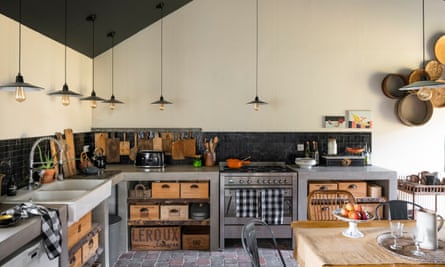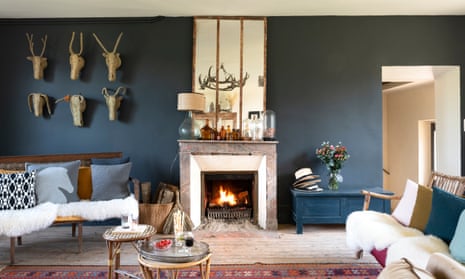When Vincent Dewas first came to view the farm that is now his Normandy home, several potential buyers had already been put off by its derelict condition. But one glance at the property and its adjoining outhouses, built in 1875, was all it took. “I didn’t need to go inside to make up my mind,” he says. “What sold it to me was its proportions, the extensive grounds and the fact it sits quietly in Le Perche national park, close to the village of Bellême, surrounded by trees and cows. I told the agent I wanted it and I signed the papers there and then on the bonnet of the car.”
In France, we take the occupation of antique-hunting so seriously that we have a verb for it – chiner
The Guardian’s product and service reviews are independent and are in no way influenced by any advertiser or commercial initiative. We will earn a commission from the retailer if you buy something through an affiliate link. Learn more.
Not many homeowners facing a full-scale renovation choose to install a swimming pool ahead of running water and heating, but that was first on the agenda when former communications director Dewas arrived in 2017: “I figured the works to the house would be both costly and stressful. The pool was factored into the budget straight off, with the idea that I could retreat there when I needed to escape the chaos.”
During the two years that it took for the farmhouse to be given an updated dose of shabby chic, Dewas made many crucial decisions poolside. It’s a relaxed attitude that proves to have served him well.
Untouched since the 1960s, the main farmhouse was exposed to the rafters and featured only a kitchen, bathroom and a couple of small bedrooms. Dewas’s plan was to take full advantage of the building’s generous volume by adding a first floor to accommodate five bedrooms and three bathrooms, and rework the ground floor to allow for a large kitchen and dining room, a sitting room and snug. “Creating an extra floor allowed me to double the size of the original layout, which made the purchase feel more like a bargain,” he says.

But the renovation was not without its complications: the roof had to be completely replaced and, due to the building’s historic nature, alterations were subject to complicated consents, leaving Dewas and his partner at the mercy of haphazard French bureaucracy. As a result, works sometimes ground to a halt for weeks at a time. On top of that, his desire to do the job once and do it well meant putting in hours of legwork.
“For me, it was all about creating a space that remained entirely in tune with its surroundings,” he explains. “This place was never going to feature swathes of marble or polished stone floors – I wanted to be able to tell at one glance that it was a Normandy house, in keeping with the local vernacular.”

Joinery was particularly important – a visit to the region’s eco-museum enabled him to consult an archive of France’s buildings, which led to choosing persimmon for much of the woodwork. Dewas replaced all the original windows on the ground floor with double glazing, but retained their typically small openings in keeping with other houses in the area. Original fireplaces, wood and brick flooring and beams were restored.
In a nod to the building’s origins, discarded tools from around the farm also played a part, including wooden cattle-feeding utensils that have been reimagined as stair rails. Meanwhile, wood from the old roof was turned into a dining table to seat 16 guests.
A keen bric-a-brac hunter, Dewas knew early on that the interiors would feature some of his treasured finds. “In France, we take the occupation of antique-hunting so seriously that we have a verb for it – chiner,” he smiles. “Now I’m on first-name terms with the owners of the many brocantes in Bellême, including a favourite called La Brocante de Brigitte, where I can pick up furniture for between €20 and €50.”
Despite weekly visits to his network of sellers, Dewas rarely swaps one piece for another. “I’ll just keep on adding until I run out of room,” he laughs. Recent acquisitions include a bamboo sofa in the sitting room, a set of cubby holes from the local post office and a pair of wicker coffee tables. “It’s about the thrill of the chase and returning home with something no one else has, at an affordable price.”
A palette of dark greens, putties and mid-blues provides an ideal backdrop for a mixture of rustic materials, from exposed wood to brick flooring. But some unusual design decisions, such as painting the sloping walls of the kitchen in a contrasting dark tone (Farrow & Ball’s Off-Black), add a contemporary note. “I didn’t want to create a pastiche country house; I just wanted it to feel authentic.”

Soon after moving in, Dewas, virtually a dyed-in-the-wool Parisian, having lived in the capital since his student days, decided to relocate entirely to Normandy. “It may seem like a big move, but I was ready for it,” he reflects. “It’s not so far from the city, but it’s fantastically peaceful. I made a plan to do up the outhouses and rent them out for events and long stays so that I can live and work in one place.”
Fortunately for Dewas there are some reminders of his old stomping ground in the form of several of his Parisian friends. “Not long ago, a few of them followed suit by buying properties within a few kilometres of this place,” he says. “It’s brilliant, as we often gather together – although it does mean that eventually I might need to invest in an even bigger dining table.”
